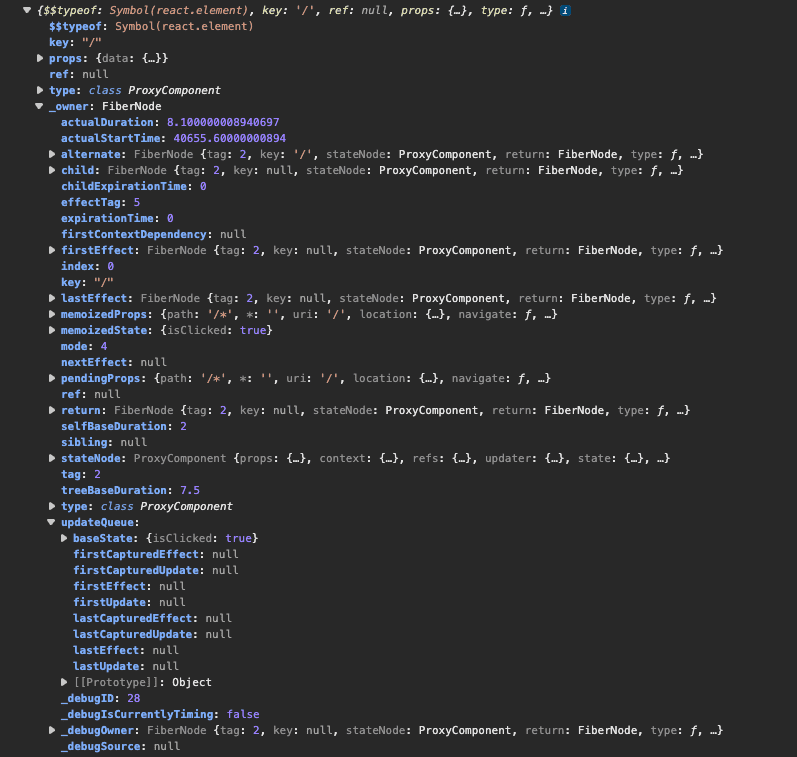React fiber object
What exactly is a fiber object?
Each instance of a component is internally represented in React as a ‘Object’, and these Objects have a lot of properties that are used by React to keep track of things like state and props.
It stores crucial information about the component it represents.
A react component structured as below
class IndexRoute extends React.Component {
constructor(props) {
super(props)
this.state = { isClicked: false }
}
render() {
const items = []
if (!this.props.data) {
return null
}
const { title, subtitle } = this.props.data.site.siteMetadata
const posts = this.props.data.allMarkdownRemark.edges
posts.forEach(post => {
console.log(<Post data={post} key={post.node.fields.slug} />)
items.push(<Post data={post} key={post.node.fields.slug} />)
})
return (
<Layout>
<div>
<Helmet>
<title>{title}</title>
<meta name="description" content={subtitle} />
</Helmet>
<button onClick={() => this.setState({ isClicked: true })}>
Click me
</button>
{this.state.isClicked && <div>Clicked</div>}
<Sidebar {...this.props} />
<div className="content">
<div className="content__inner">{items}</div>
</div>
</div>
</Layout>
)
}
}will be represented as object, as shown below
This object is used internally by react to represent a element or node within the component tree.
These properties work together to manage rendering, updates, and debugging. Core ones like child/sibling/return form the tree structure, while effects and expiration handle scheduling.
Let’s breakdown some important properties:
- $$typeof: This property is used to identify and differentiate React elements from regular JSON.
Read the original pull request to understand the rationale why $$typeof should exist:
According to “Sebastian Markbåge” who made this change, the primary motivation is to prevent XSS attacks in react_v0.14.
Since Symbols cannot be stored in JSON as Symbols are non-string, non-serializable primitives in JavaScript. User input JSON, containing $$typeof with a symbol is not a possibility.
React will check element.$$typeof , and will refuse to process the element if it’s missing or invalid.
/**
* Verifies the object is a ReactElement.
* See https://reactjs.org/docs/react-api.html#isvalidelement
* @param {?object} object
* @return {boolean} True if `object` is a ReactElement.
* @final
*/
export function isValidElement(object) {
return (
typeof object === 'object' &&
object !== null &&
object.$$typeof === REACT_ELEMENT_TYPE
);
}These are the possible values for $$typeof in react:
var symbolFor = Symbol.for;
REACT_ELEMENT_TYPE = symbolFor('react.element');
REACT_PORTAL_TYPE = symbolFor('react.portal');
exports.Fragment = symbolFor('react.fragment');
REACT_STRICT_MODE_TYPE = symbolFor('react.strict_mode');
REACT_PROFILER_TYPE = symbolFor('react.profiler');
REACT_PROVIDER_TYPE = symbolFor('react.provider');
REACT_CONTEXT_TYPE = symbolFor('react.context');
REACT_FORWARD_REF_TYPE = symbolFor('react.forward_ref');
REACT_SUSPENSE_TYPE = symbolFor('react.suspense');
REACT_SUSPENSE_LIST_TYPE = symbolFor('react.suspense_list');
REACT_MEMO_TYPE = symbolFor('react.memo');
REACT_LAZY_TYPE = symbolFor('react.lazy');
REACT_BLOCK_TYPE = symbolFor('react.block');
REACT_SERVER_BLOCK_TYPE = symbolFor('react.server.block');
REACT_FUNDAMENTAL_TYPE = symbolFor('react.fundamental');
REACT_SCOPE_TYPE = symbolFor('react.scope');
REACT_OPAQUE_ID_TYPE = symbolFor('react.opaque.id');
REACT_DEBUG_TRACING_MODE_TYPE = symbolFor('react.debug_trace_mode');
REACT_OFFSCREEN_TYPE = symbolFor('react.offscreen');
REACT_LEGACY_HIDDEN_TYPE = symbolFor('react.legacy_hidden');Fallback when symbol is not supported
The fallback solution is a plain well-known number.
var REACT_ELEMENT_TYPE = 0xeac7;Why this number specifically? 0xeac7 kinda looks like “React”. - Dan Abramov
-
key: Used during reconciliation to determine if a fiber can be reused when components are reordered
-
type: Describes what kind of component this represents - for composite components it’s the function/class, for DOM elements it’s a string like “div”
-
tag: Numeric identifier indicating the fiber type (FunctionComponent, ClassComponent, HostComponent, etc.)
below are the possible Numeric identifiers for tag property in react
export const FunctionComponent = 0;
export const ClassComponent = 1;
export const HostRoot = 3; // Root of a host tree. Could be nested inside another node.
export const HostPortal = 4; // A subtree. Could be an entry point to a different renderer.
export const HostComponent = 5;
export const HostText = 6;
export const Fragment = 7;
export const Mode = 8;
export const ContextConsumer = 9;
export const ContextProvider = 10;
export const ForwardRef = 11;
export const Profiler = 12;
export const SuspenseComponent = 13;
export const MemoComponent = 14;
export const SimpleMemoComponent = 15;
export const LazyComponent = 16;
export const IncompleteClassComponent = 17;
export const DehydratedFragment = 18;
export const SuspenseListComponent = 19;
export const ScopeComponent = 21;
export const OffscreenComponent = 22;
export const LegacyHiddenComponent = 23;
export const CacheComponent = 24;
export const TracingMarkerComponent = 25;
export const HostHoistable = 26;
export const HostSingleton = 27;
export const IncompleteFunctionComponent = 28;
export const Throw = 29;
export const ViewTransitionComponent = 30;